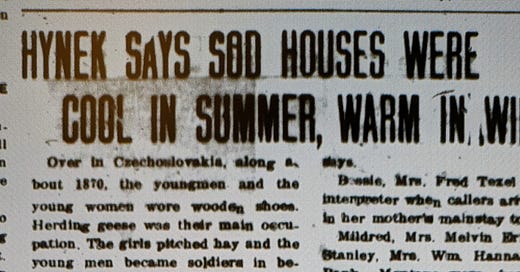HYNEK SAYS SOD HOUSES WERE COOL IN SUMMER, WARM IN WINTER
Another citizen profile in The Stanley Sun,
HYNEK SAYS SOD HOUSES WERE COOL IN SUMMER, WARM IN WINTER
Over in Czechoslovakia, along about 1870, the young men and the young women wore wooden shoes. Herding geese was their main occupation. The giris pitched hay and the young men became soldiers in between times. When you went to the army, for enforced military training. they gave you leather shoes-luxury if you came from a right family you stood a chance of becoming an army officer. If so, you wore boots and fancy clothes. An army officer was rated the highest in society. Doctors and barbers were in the same catágory, but army officers were something. A military nation, armed to protect itself.1
Mr. and Mrs. Karl Hynek2, Mr. and Mrs. Blank last week, came from Czechoslovakia. Their childhood was geese, wooden shoes, and militarism. There were 8 children in Karl's family and Katrina Jurdia came from a family of eleven. Their country has vanished from the map, so far as boundary lines are concerned, but the memories linger in the minds of Karl and Katrina. Sunday morning Kari and Katrina go to church. She is not so surefooted so Karl offers his arm-a good secure one.. They go to the Catholic church bend their knees in prayer, confess their sins (of which they have none) and are mighty good folks to know.
In the "old country" Karl and Katrina worked in a tannery. It was not a pleasant occupation. Karl was ambitious so was Katrina, Karl liked Katrina and Katrina liked Karl The priest was called and it don't take. many guesses to know the results. Karl said "Ja" and Katrina nodded her head. The first child was Beatrice She died at the age of five. The next two were Charley and Bess. They came across the ocean with Karl and Katrina.
The year was 1901, the month was June. The boat came over, it was a German boat which had been christened "Kaiser Willhelm" It was a good boat and the voyage was uneventful. Mr. and Mrs. Karl Hynek took up their residence at Prague. Nebraska.
In 1905 Karl filed on a homestead in Dohing(?) township. In 1906 Mrs Hynek and the children arrived and the Hyneks become Mountrail county pioneers. Their equipment for farming consisted of 3 horses, one old wagon, a drag, and a walking plow.
The first house was a claim shack but the following summer Karl built something substantial. He gathered his material from the virgin prairie - sod. There was no shortage of material and the house when finished was cool in summer and warm in winter.
NOT the Hynek house…but an example taken from the the State Historical Society collection. Note the doorway showing the really thick walls. I wonder if the second smaller door was for livestock? Note the grindstone and tall window.
This link:
https://statemuseum.nd.gov/photobook?detail=%22sod+house%22&CollectionNmbr=&items_per_page=50&antibot_key=iLAxfoC4TyhDAx916bxkILPlXU7-YxpaLEjEAQkumjw
will take you to the ND state museum collection of photos of pioneer sod houses. All are of unique design.
The first winter was a bad one. Three neighbors Frank, Slemin, Lewis Vachal, and John Cvancara came to play cards and spend the evening a storm came up and Karl recalls that they sat up all night feeding flax straw into the heater. Another time, Karl started for the coal mine3, met a blizzard and turned back. The drifts buried the sod house and Karl chopped a hole in the roof of the barn to feed and water the livestock. That storm lasted three days.4
Because the land of their birth is in the news, we were curious when we interviewed Karl and Mrs. Hynek. They walked to dances. When Karl went courting, he walked. Dances were held about three times a year and were on the order of a festival.
Charley Hynek, who runs the Standard Oil bulk station in Stanley was born at 11am so his mother says.
Bessie, Mrs. Fred Tezel acted as interpreter when callers arrived. She is her mother's mainstay to this day.
Mildred, Mrs. Melvin Erickson of Stanley,
Mrs. Wm. Hannah of Cut Bank, Montana were born on the homestead;
Antonia, Mrs. Claude Brown resident of Dodson, Montana and
Lydia, Mrs. Elmer Hilde resident of Grenora.
There are 21 grandchildren and six great grandchildren. And did you ever see a feathered quilt? Mrs. Hynek makes them. She has made one for each one of her children and a few more. You strip the down off the feathers. sew it in the quilt, and there you are. They are mighty nice quilts, but try making one someday.
They moved to Stanley about four years ago to be near their children And those children remember Ma. and Pa. Bessie, Mildred and Charley are in there pitching. Just sort of looking after two of the finest old folks we know.5
The late Mrs. Albert Molzhon was a daughter of Mr. Hynek by a former marriage, and Mrs. Frank Hynek is Mr. Hyneks daughter by a former marriage.
Remember, this editor doesn’t like the war underway in Europe. Here in Stanley there is no military elite…no military at all.
Karl Hynek 1871- 1957
Katherine 1869 - 1959
Marie Hynek 1893 - 1986
Karel Hynek 1898 - 1974
Antonia Marie Hynek 1903 - 1986
Mildred Hynek 1909 - ?
Alžběta Hynek 1896 - 1901
Bessie Hynek 1900 - 1984
Lillian Rosalie Hynek 1905 - 1965
Josephine Marie Hynek 1912 - 1978
I’ve seen in the papers of the early newspapers advertisements for coal. That is a seperate and important story to settling the prairie.
Perhaps that was the Blizzard of 1920 that has its own Wikipedia page. 34 people killed.
I think the Hynek name is still around Stanley. I seem to recall a Hynek at Stanley High School who might have graduated around 1962.





